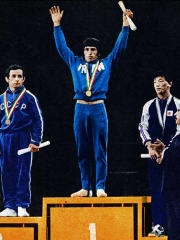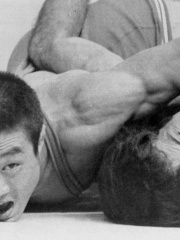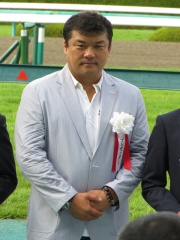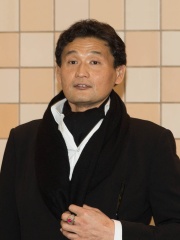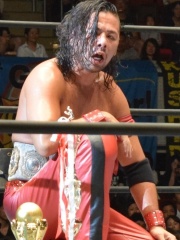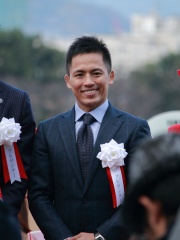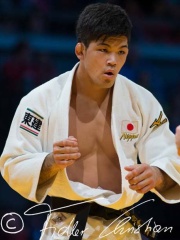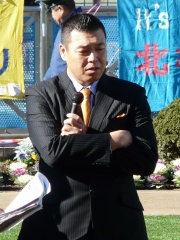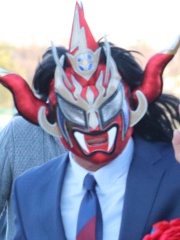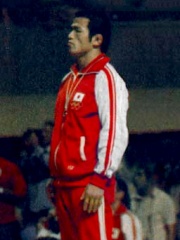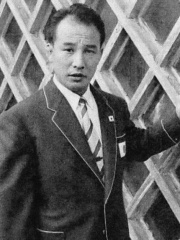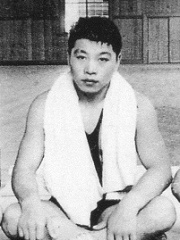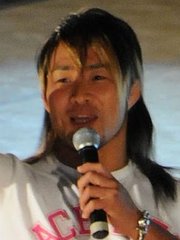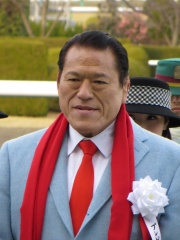
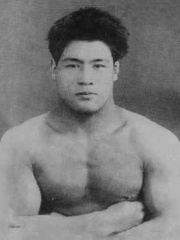
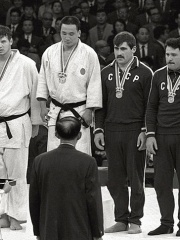
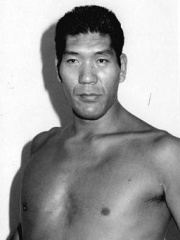
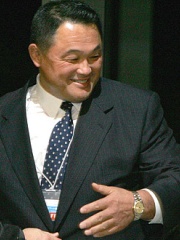
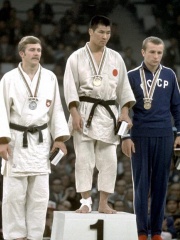
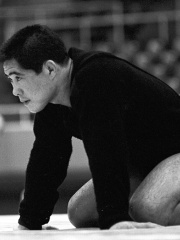
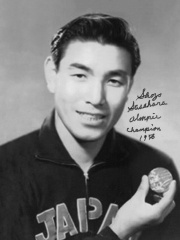
The Most Famous
WRESTLERS from Japan
Top 10
The following people are considered by Pantheon to be the top 10 most legendary Japanese Wrestlers of all time. This list of famous Japanese Wrestlers is sorted by HPI (Historical Popularity Index), a metric that aggregates information on a biography's online popularity. Visit the rankings page to view the entire list of Japanese Wrestlers.

1. Antonio Inoki (1943 - 2022)
With an HPI of 72.34, Antonio Inoki is the most famous Japanese Wrestler. His biography has been translated into 33 different languages on wikipedia.
Antonio Inoki (アントニオ猪木, Antonio Inoki) (born Kanji Inoki (Japanese: 猪木寛至, Hepburn: Inoki Kanji); 20 February 1943 – 1 October 2022) was a Japanese professional wrestler, professional wrestling trainer, martial artist, politician, and promoter of professional wrestling and mixed martial arts (MMA). He is best known as the founder and 33-year owner of New Japan Pro-Wrestling (NJPW). He is considered to be one of the most influential professional wrestlers of all time, and one of the biggest key influences on MMA in Japan and internationally. After spending his adolescence in Brazil, Inoki began his professional wrestling career in the 1960s for the Japan Pro Wrestling Alliance (JWA) under the tutelage of Rikidōzan. After he changed his in-ring moniker to Antonio Inoki in 1963, a homage to accomplished Italian wrestler Antonino Rocca, Inoki became one of the most popular stars in Japanese professional wrestling. He is credited with developing strong style and shoot style wrestling in the 1970s and 1980s. He parlayed his wrestling career into becoming one of Japan's most recognizable athletes, a reputation bolstered by his 1976 fight against world champion boxer Muhammad Ali — a fight that served as a predecessor to modern day MMA. In 1995 Inoki headlined two shows with Ric Flair in North Korea that drew 165,000 and 190,000 spectators, the highest attendances in professional wrestling history. Inoki wrestled his retirement match on 4 April 1998 against Don Frye, and was inducted into the WWE Hall of Fame in 2010. Inoki was a twelve-time professional wrestling world champion, notably being the inaugural IWGP Heavyweight Champion and the first Asian WWF Heavyweight Champion, a reign not officially recognized by WWE. Inoki began his promoting career in 1972, when he founded New Japan Pro-Wrestling. He remained the owner of NJPW until 2005 when he sold his controlling share in the promotion to the Yuke's video game company. In 2007, he founded the Inoki Genome Federation (IGF). In 2017, Inoki founded ISM and the following year left IGF. He was also a co-creator of the karate style Kansui-ryū (寛水流, Kansui-ryū) along with Matsubayashi-ryū master Yukio Mizutani. In 1989, while still an active wrestler, Inoki entered politics as he was elected to the Japanese House of Councillors. During his first term with the House of Councillors, Inoki successfully negotiated with Saddam Hussein for the release of Japanese hostages in Iraq before the outbreak of the Gulf War. While in Iraq, Inoki converted to Shia Islam and adopted the Islamic moniker Muhammad Hussain Inoki (Arabic: محمد حسين اينوكي, romanized: Muhamad Husayn Aynwky). His first tenure in the House of Councillors ended in 1995, but he was reelected in 2013. In 2019, Inoki retired from politics.

2. Masahiko Kimura (1917 - 1993)
With an HPI of 66.71, Masahiko Kimura is the 2nd most famous Japanese Wrestler. His biography has been translated into 34 different languages.
Masahiko Kimura (木村 政彦, Kimura Masahiko; 10 September 1917 – 18 April 1993) was a Japanese judoka and professional wrestler. He won the All-Japan Judo Championships three times in a row for the first time in history and had never lost a judo match from 1936 to 1950. In submission grappling, the reverse ude-garami arm lock is often called the "Kimura", due to his famous victory over Gracie jiu-jitsu co-founder Hélio Gracie. In the Japanese professional wrestling world, he is known for being one of Japan's earliest stars and the controversial match he had with Rikidōzan.

3. Isao Inokuma (1938 - 2001)
With an HPI of 61.49, Isao Inokuma is the 3rd most famous Japanese Wrestler. His biography has been translated into 19 different languages.
Isao Inokuma (猪熊 功, Inokuma Isao; February 4, 1938 – September 28, 2001) was a Japanese judoka. He won a gold medal in the heavyweight division (above 80 kg) at the 1964 Summer Olympics in Tokyo and a world title in 1965.

4. Giant Baba (1938 - 1999)
With an HPI of 59.71, Giant Baba is the 4th most famous Japanese Wrestler. His biography has been translated into 16 different languages.
Shohei Baba (馬場 正平, Baba Shōhei; January 23, 1938 – January 31, 1999), best known by his ring name Giant Baba (ジャイアント馬場, Jaianto Baba), was a Japanese professional wrestler, promoter, and professional baseball player. He is best known as a co-founder of All Japan Pro Wrestling (AJPW), a promotion he founded in 1972 along with Mitsuo Momota and Yoshihiro Momota, the sons of his mentor Rikidōzan. For the first 10 years of its existence, Baba was the top star of All Japan, while also serving as the booker, promoter, head trainer and president of the promotion from its inception in 1972 till his death in 1999. Baba was also responsible for recruiting much of the talent for All Japan, and was the public face of the promotion for much of his lifetime. Considered one of the most beloved Japanese wrestlers ever, Baba was a national hero with a level of popularity in Japan comparable to that of Hulk Hogan in the United States. The 2006 Top 100 Historical Persons in Japan survey ranked Baba the 93rd greatest person in the history of Japan, as voted for by the general public. Among his many accomplishments, Baba was a record seven-time winner of the Champion Carnival, a four-time PWF World Heavyweight Champion, three time NWA International Heavyweight Champion and a three-time NWA World Heavyweight Champion.
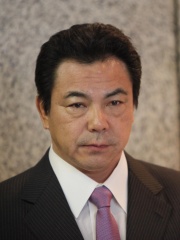
5. Chiyonofuji Mitsugu (1955 - 2016)
With an HPI of 59.35, Chiyonofuji Mitsugu is the 5th most famous Japanese Wrestler. His biography has been translated into 27 different languages.
Chiyonofuji Mitsugu (Japanese: 千代の富士 貢; June 1, 1955 – July 31, 2016), born Mitsugu Akimoto (秋元 貢, Akimoto Mitsugu), was a Japanese professional sumo wrestler and the 58th yokozuna of the sport. Chiyonofuji was considered one of the greatest yokozuna in sumo's history, winning 31 tournament championships (yūshō) at the top division (makuuchi), second only to Taihō at the time of his retirement. He was particularly remarkable for his longevity in sumo's top rank, which he held for a period of ten years from 1981 to 1991. Promoted at the age of twenty-six after winning his second championship, his performance improved with age, winning more tournaments in his thirties than any other wrestler and dominating the sport in the second half of the 1980s. He finally retired in May 1991, just short of his thirty-sixth birthday. Following his retirement as a wrestler, he became an elder (oyakata) of the Japan Sumo Association and became the Kokonoe-oyakata the following year in 1992, serving as the stable master of Kokonoe stable until his death. During his 21-year professional career, Chiyonofuji set records for most career victories (1045) and most wins in the top makuuchi division (807), earning an entry in the Guinness World Records, although both of these records were later broken by Kaiō. He won the November Kyushu tournament, one of the six annual honbasho, a record eight consecutive years from 1981 until 1988, and also set the record for the longest postwar run of consecutive wins (53 bouts in 1988). That record stood for 22 years until Hakuhō broke it with his 54th straight win in September 2010. In a sport where weight is often regarded as vital, Chiyonofuji was comparatively light at around 120 kg (260 lb), making him the lightest yokozuna since Tochinoumi during the 1950s and 60s; he primarily relied on his muscle and superior technique to defeat his opponents. Chiyonofuji was a popular sumo wrestler who also went by his nickname "The Wolf" (ウルフ, Urufu) due to his muscular build atypical of most other sumo wrestlers, his competitive ferocity, and his appeal as a sex symbol owing to his body and his masculine facial features.

6. Yasuhiro Yamashita (b. 1957)
With an HPI of 58.80, Yasuhiro Yamashita is the 6th most famous Japanese Wrestler. His biography has been translated into 35 different languages.
Yasuhiro Yamashita (山下 泰裕, Yamashita Yasuhiro; born 1 June 1957) is a Japanese judoka. He currently works as an instructor or advisor for numerous organizations, including Tokai University, the International Judo Federation, and the All Japan Judo Federation. He retired from competitive judo on 17 June 1985 after a remarkable career where he won five gold medals in international competitions and marked 203 consecutive victories (with 7 draws in-between) until his retirement where he went undefeated his entire career against non-Japanese wrestlers. He received the Japanese National Prize of Honor on 9 October 1984. He is considered by many to be the greatest judoka ever.

7. Takehide Nakatani (b. 1941)
With an HPI of 58.71, Takehide Nakatani is the 7th most famous Japanese Wrestler. His biography has been translated into 23 different languages.
Takehide Nakatani (中谷 雄英, Nakatani Takehide; born 9 July 1941) is a retired judoka who won the first gold medal ever awarded in judo at the Summer Olympics as the Japanese competitor in the lightweight division (–68 kg).

8. Osamu Watanabe (1940 - 2022)
With an HPI of 56.51, Osamu Watanabe is the 8th most famous Japanese Wrestler. His biography has been translated into 18 different languages.
Osamu Watanabe (渡辺 長武, Watanabe Osamu; October 21, 1940 – October 1, 2022) was a Japanese freestyle wrestler. In 1962 (Toledo, Ohio), he debuted internationally and was the reigning world champion, when he capped off his career with a gold medal for Japan in freestyle wrestling at the 1964 Olympics, retiring from competition shortly afterwards as the only undefeated Olympic champion to date at 189–0. He is considered one of the best wrestlers in Olympic history. In the early 2000s Watanabe resumed competing internationally in the masters category. He died of a heart attack on October 1, 2022.

9. Shozo Sasahara (1929 - 2023)
With an HPI of 56.41, Shozo Sasahara is the 9th most famous Japanese Wrestler. His biography has been translated into 17 different languages.
Shozo Sasahara (笹原 正三, Sasahara Shōzō; July 28, 1929 – March 5, 2023) was a Japanese freestyle wrestler who won a world title in 1954 and an Olympics gold medal in 1956. He was the flag bearer for Japan at the 1956 Games. During his career Sasahara won approximately 200 bouts. After retiring from competitions he worked as a national coach. His trainees included Osamu Watanabe. Sasahara is credited with having designed "bound tennis" in 1980, which is a form of tennis played on a small-sized court. In 1981 he became the founding president of the Japan Bound Tennis Association. Between 1989 and 2003 Sasahara was president of Japan Wrestling Association. For many years he also served as Vice-President of United World Wrestling (FILA), and was later named its Honorary Vice-president. In 2006 he was inducted to the FILA International Wrestling Hall of Fame. Sasahara died on March 5, 2023, at the age of 93.
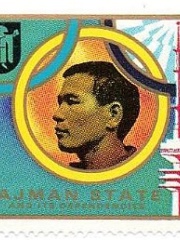
10. Shinobu Sekine (1943 - 2018)
With an HPI of 55.55, Shinobu Sekine is the 10th most famous Japanese Wrestler. Her biography has been translated into 22 different languages.
Shinobu Sekine (関根 忍, Sekine Shinobu; 20 September 1943 – 18 December 2018) was a Japanese middleweight judoka. He won a gold medal at his only Olympics in 1972.
People
Pantheon has 103 people classified as Japanese wrestlers born between 1895 and 2003. Of these 103, 87 (84.47%) of them are still alive today. The most famous living Japanese wrestlers include Yasuhiro Yamashita, Takehide Nakatani, and Asuka. The most famous deceased Japanese wrestlers include Antonio Inoki, Masahiko Kimura, and Isao Inokuma. As of April 2024, 12 new Japanese wrestlers have been added to Pantheon including Hiroshi Tanahashi, Mitsuru Sato, and Yōsuke Yamamoto.
Living Japanese Wrestlers
Go to all RankingsYasuhiro Yamashita
1957 - Present
HPI: 58.80
Takehide Nakatani
1941 - Present
HPI: 58.71
Asuka
1981 - Present
HPI: 53.96
Yuji Takada
1954 - Present
HPI: 53.09
Kiyomi Kato
1948 - Present
HPI: 52.52
Hidehiko Yoshida
1969 - Present
HPI: 51.07
Takanohana Kōji
1972 - Present
HPI: 50.76
Shinsuke Nakamura
1980 - Present
HPI: 50.00
Tadahiro Nomura
1974 - Present
HPI: 49.90
Shohei Ono
1992 - Present
HPI: 49.72
Naoya Ogawa
1968 - Present
HPI: 49.49
Jushin Liger
1964 - Present
HPI: 48.58
Deceased Japanese Wrestlers
Go to all RankingsAntonio Inoki
1943 - 2022
HPI: 72.34
Masahiko Kimura
1917 - 1993
HPI: 66.71
Isao Inokuma
1938 - 2001
HPI: 61.49
Giant Baba
1938 - 1999
HPI: 59.71
Chiyonofuji Mitsugu
1955 - 2016
HPI: 59.35
Osamu Watanabe
1940 - 2022
HPI: 56.51
Shozo Sasahara
1929 - 2023
HPI: 56.41
Shinobu Sekine
1943 - 2018
HPI: 55.55
Katsutoshi Naito
1895 - 1969
HPI: 55.33
Jiichiro Date
1952 - 2018
HPI: 54.84
Shohachi Ishii
1926 - 1980
HPI: 52.81
Mitsuo Ikeda
1935 - 2002
HPI: 52.69
Newly Added Japanese Wrestlers (2025)
Go to all RankingsHiroshi Tanahashi
1976 - Present
HPI: 48.05
Mitsuru Sato
1961 - Present
HPI: 46.95
Yōsuke Yamamoto
1960 - Present
HPI: 45.98
Kosei Akaishi
1965 - Present
HPI: 45.97
Takashi Kobayashi
1963 - Present
HPI: 44.04
Iyo Sky
1990 - Present
HPI: 42.45
Kenji Inoue
1976 - Present
HPI: 42.12
Yukimasa Nakamura
1972 - Present
HPI: 40.06
Ryuju Nagayama
1996 - Present
HPI: 39.22
Chikara Tanabe
1975 - Present
HPI: 38.90
Huh Mi-mi
2002 - Present
HPI: 36.38
Haruna Murayama
1999 - Present
HPI: 33.86
Overlapping Lives
Which Wrestlers were alive at the same time? This visualization shows the lifespans of the 10 most globally memorable Wrestlers since 1700.


